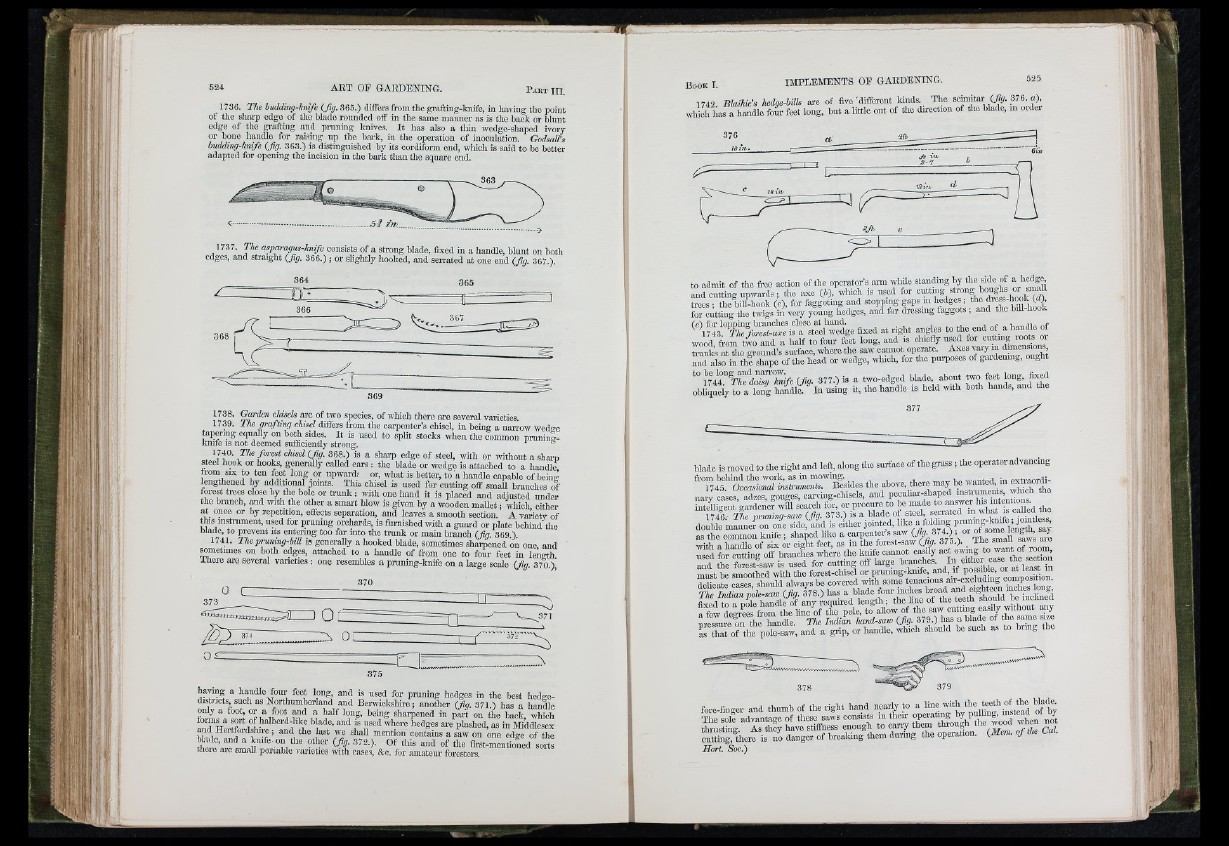
ifri r
A E T OF GAEDENING. P akt m . Book I. IMPLEMENTS OF GAEDENING.
1736. The huMing-hiife (Jig, 36.5.) differs from the grafting-knife, in having the point
of tlie sharp edge of tho blade rounded off in the same manner as is tho hack or blunt
edge of the grafting and pruning knives. I t has also a tliin wedge-shaped ivory
or bone handle for raising up the bark, iu the operation of inoculation. Godsall’s
budding-knife (fig. 363.) is distinguished hy its cordifbrm end, wliich is said to be better
adapted for opening the incision in the bark than the square end.
363
1737. The asparagus-hnife consists of a strong blade, flxcd in a handle, blunt on both
edges, and straight {jig. 3 66.); or slightly hooked, and serrated at one end {jig. 367.).
1738. Garden chisels are of two species, of which there axe several varieties.
1739. The grafting chisel differs from the carpenter’s chisel, in being a n a r iw wedge
tapering equally on both sides. I t is used to split stocks when the common pruniiig-
kmtc IS not deemed sufficiently strong.
1740. The fo r ^ t chisel (fig. 368.) is a shaip edge of steel, with or without a sharp
steel hook or hooks, generally called ears .- the blade or wedge is attached to a handle
trom SIX to ten feet long or upwai-df or, what is better, to a handle capable of being
lengthened by additiouM joints. Tlm, chisel is used for cutting off small branches of
forest trees close by the bole or tnm k : with one hand it is placed and adjusted under
tho branch, and with the other a smart blow is given by a wooden m a lle t: which either
a t once or by repetition, effects separation, and leaves a smooth section. A variety of
this instrument, used for pruning orchards, is furnished with a guard or plate behind the
blade, to prevent its entenng too far into the trunk or main branch (fig 369 )
1741. The pruni^ng-bill is generally a hooked blade, sometimes shaipened o t one, and
rometimes on both edges, attached to a handle of from one to four feet in length
Ihero ai-e several varieties: one resembles a pmuing-knife on a large scale (fig 370 )'
Ü c
370
375
hainng a handle four feet long, and is used for pruning hedges in the best hedge-
districts, such as Northumberland and Berwickshire; another (fiq. 371.) has a handle
foLms? ; i f i M if sharpened in part on the back, which
forms a soit of halbcrd-like blade, and is used where hedges are plashed, as in Middlesex
and Hertfordshire; and the last we shall mention contains a saw on one edge of the
f h f f ’ “ “ ? Gfy- 3?2-)- Of this and of the flrst-mentioLed sorts
thcie aio «mall paftable varieties with cases, &c. for amateur foresters.
1742 B h ik ie ’s hedqe-bills ai'e of flve‘different kinds. The scimitar (/</. 376. o),
which has a handle four feet long, but a little out of the direction of tho blade, m oidoi
to admit of the free action of the operator s an n vvhile standing hy “ e side of " hed„e
and cutting upwards; the axe (6), which ,s used for houghs^
tre e s ; the bill-liook (c). for faggoting and stoppmg gaps m hedges; the
for eftting tho twigs in very young hedges, and for dressing faggots ; and the hdl-hoox
(e') for lopping branches close at hand. i . „i, ^ inQnair» nf
1743 The forest-axc is a steel wedge fixed at right angles to the end of a handle of
wood from two and a half to four feet long, and is clnefly used for cutting roots oi
trunks at the ground’s surface, where the saw cannot operate. Axes vaiy in dmiensions,
a™ a L f i ? h ? s l “ p o L the h ta d or wedge, which, for the pmposes of gardening, ought
377.) is a two-edged blade, about two feet long, fixed
obiqueiy to a lOTg handlm Li ustag it, the handle is held with both hands, and the
blade is moved to the right and left, along the surface of the grass ; the operator adyanclng
Braides the above, there may he “ L h M ° t e
mi-v cases adzes gouges, carving-chiscls, and peouhar-shaped mstiumeffis, which tne
double 'manner on one side, and is either jomted,
as the common knife ; shaped like a carpenter’s saw (fig 374 ) ; oi “ / " f “ ’
with a handle of six or eight feet, as in the forest-saw (fig. 375.). ^ The smidl ®aws mo
used for cutting off branches where the knife cannot easily act owing to want of room,
Z t e C f e s L i s used for cutting off large brauehes. ? h e y "SO t e ^
TniiRi hP smoothed with the forest-chisel or pruning-kmfe, and, if possible, or at least in
delicate cases should always be covered with some tenacious air-ex o lu teg composition.
S that of t e pole-saw, and a grip, or handle, which should be such as to bimg the
„ . » . . r o ? ?
fore-finger and thumb of t e right hand nearfy to a M by
The sole advantage of these saws consists in t e i r ,,h en not
thrasting. As they have stiffness enough to c a n y them thiou„ ^
cutting, there is no danger of breaking them during the operation. ( . /
H o rt Soc.)
a
i
i 'I